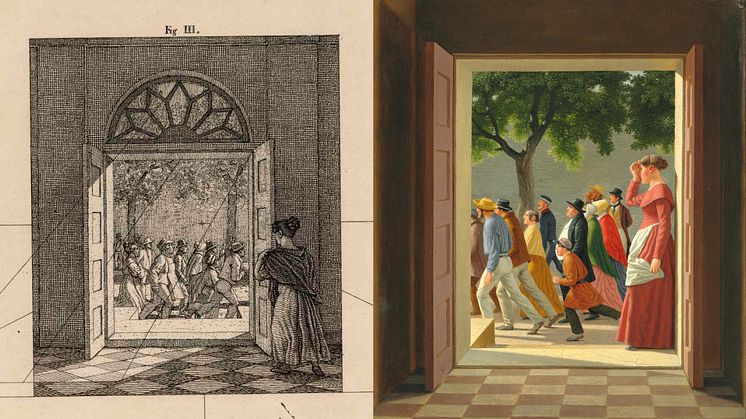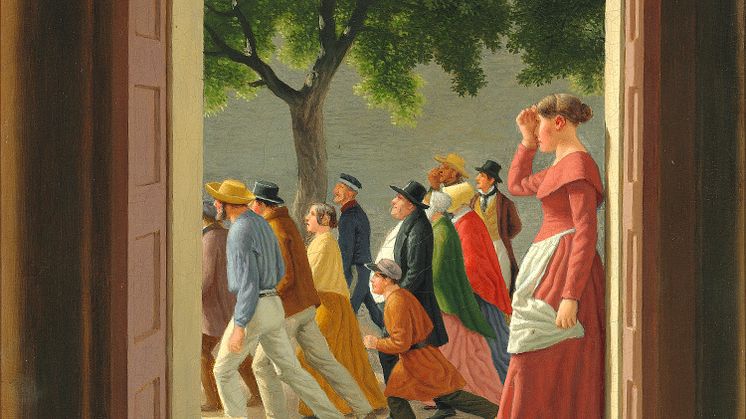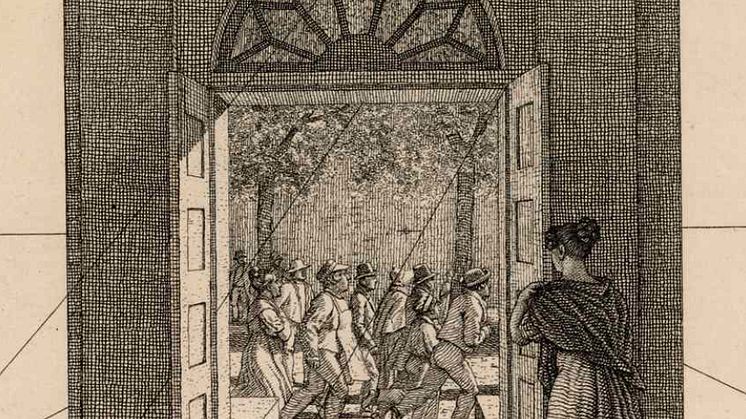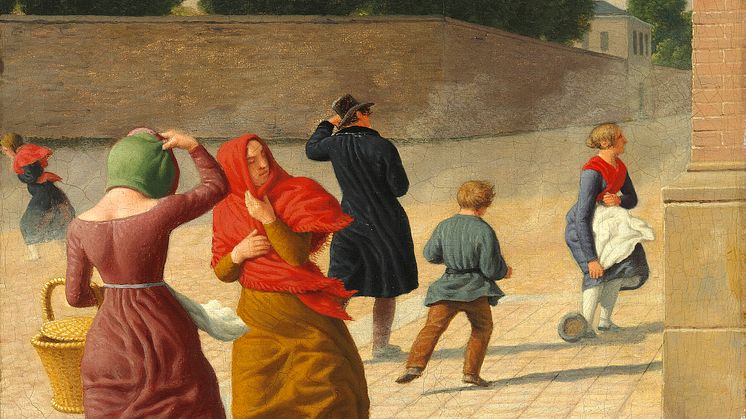
Press release -
Eckersberg – A Pioneer of Perspective
The year’s biggest international auction is right around the corner at Bruun Rasmussen in Copenhagen, where we among other items can present two completely unique works by the father of Danish painting C.W. Eckersberg (1783-1853). He helped influence an entire generation of artists during his own time and is today as popular as ever. Ahead of the auction, a number of selected works from the Danish Golden Age will be exhibited in London on 6-7 November.
"Museums and art collectors around the world are flocking to the works of the Danish Golden Age painter C.W. Eckersberg, who is currently enjoying great international attention. There are several good reasons for this – the artist is not only the father of Danish painting but also a proponent of an artistic view that is a precursor to modern painting and extends far beyond the borders of Denmark. Two of the auction's most remarkable paintings combine central themes of the artist's oeuvre, including the depiction of moments and the use of a central perspective," says Julie Arendse Voss, head of the department of fine art at Bruun Rasmussen.
"View Through a Door" and "A Storm"
Common to the auction's two remarkable works by Eckersberg is the depiction of everyday life in Copenhagen in the mid-1840s, which he reproduces in the so-called genre works.
In one painting, "View Through a Door to Figures Running," a crowd can be seen running down the street. The motif itself is framed by a doorway, where you can only see a smaller section of the street full of people. The very precise framing of the subject emphasizes the central perspective that directs the eye directly into the centre of the painting. A young girl stands in the doorway with the sun on her face and searches for something outside the picture frame. Eckersberg captures the action and creates a moment without a story. As a viewer, you are wondering what is really going on and tempted to add new chapters of a story both before and after the moment depicted in the painting.
In the second piece, "A Storm", Eckersberg has moved out onto the street and been caught by a fierce storm. Here, the perspective is broader. It is aided by the movement of people, the wind in their clothes, the long shadows, the paving of the road and the wall in the background, which leads the viewer’s gaze down the street where sand is flying in the face of the passersby. Presumably, it is the first time that an artist depicts clouds of dust swirling up from the street in the wind. In his diary, Eckersberg describes the creation of this work. The first time it is mentioned is 12 April 1845: "Planning a small genre work," and the second time on 16 May 1845: "Worked on and finished a small genre work "A Storm.”"
Professor Eckersberg and the Perspective
C.W. Eckersberg is one of the truly great figures within Danish art. He has been called "The Father of Danish Painting" and was a role model for an entire generation of artists in the first half of the 19th century, where he served as a professor at the Royal Danish Academy of Fine Arts in Copenhagen through 35 years – from 1818 to his death in 1853. He was motivated by exquisite artistic perfection and possessed an unrivalled technical talent that irrevocably set new standards for painting in Denmark.
As a young man, Eckersberg was educated at the Royal Danish Academy of Fine Arts in Copenhagen and was later influenced by his Grand Tour of Europe (1810-16), during which he was taught in Paris by the French Neoclassicist painter Jacques-Louis David, who specialized in figurative and historic painting. Subsequently, Eckersberg went to Rome where he made his first outdoor paintings – an approach to painting he passed on to his own students later in life. When he returned to Copenhagen in 1816, he continued his in-depth studies of nature and diligently wrote down different weather conditions, which he would then reproduce in his seascapes, genre works, city- and landscapes. He was also the first in Denmark to introduce figure studies with nude women at the Academy. Another of his significant achievements was the publication of his teachings on perspective for educational purposes. With the publication ”Forsøg til en Veiledning i Anvendelse af Perspektivlæren for unge Malere” (An Attempt at a Guide to the Use of Perspective for Young Painters) (1833) and “Linearperspektiven, anvendt paa Malerkunsten”(The Linear Perspective Used in the Art of Painting) (1841), Eckersberg approached art scientifically and argued for guiding the students beyond the traditional figure studies and teach them how to "arrange a composition" with mathematical precision.
In "The Linear Perspective Used in the Art of Painting" (1841) Table V. Figure III, Eckersberg reproduces a composition as an example of how to emphasize the central perspective with light and shadows. The composition consists of a motif that resembles the featured work of "View Through a Door to Running Figures" (1845). It is clear to see how the art professor works with his own teachings on perspective in the genre works from the mid-1840s. For Eckersberg there was always an interplay between the sensory experience and an underlying order in the artwork. The objects should have the proper proportions and be convincingly placed in relation to each other – completely without a trace of the flat surface on which they were painted. The goal was to create the perfect illusion, as is the case with the two works "View Through a Door to Running Figures" and "A Storm”.
Danish National Heritage
The art of the Danish Golden Age is of high value and holds an important place in art history as well. Sometimes the works from this period are characterized as irreplaceable cultural heritage by the Danish state, which means that a given work cannot be taken out of Denmark. This was the case when Eckersberg’s ”View Through a Door to Running Figures” (1845) was sold at one of our auctions in 1998. Now the work is up for sale again. It is, however, not a given that the verdict will be the same as last time, so everyone is welcome to join the bidding. If the work is acquired by an international buyer, then an export license has to be applied for at the Danish commission on the export of cultural assets. The export license cannot be applied for before the new hammer price has been determined.
Exhibition in London
Shapero Modern Gallery, 32, St. George Street, London W1S 2EA
Exhibition: 6-7 November from 10 am to 5 pm
Cocktails: 7 November from 6 to 8 pm
Auction in Copenhagen
Bruun Rasmussen Auctioneers, Bredgade 33, Copenhagen
Preview: 23-27 November
Auction: 28 November
.
Topics
Categories
Bruun Rasmussen Auctioneers is one of Scandinavia’s leading international auction houses, and one of Denmark’s oldest. It all started on 6 October 1948, when Arne Bruun Rasmussen conducted the first traditional auction in the saleroom at Bredgade 33 in Copenhagen. Today, Jesper Bruun Rasmussen stands at the helm of the family-run business together with the third generation of the family, his son Frederik and daughter Alexa, and the company’s CEO Jakob Dupont.
In 2004, the first online auction was launched, and today the auction house has expanded to include departments in Copenhagen and Aarhus and representations in Sweden, Germany, France, Belgium, Luxemburg, Spain, Italy, Thailand and the US. About 100,000 lots are put up for auction each year at the traditional auctions and daily online auctions. Here you can bid on everything from art, antiques, modern design and jewellery to books, coins, stamps, wine and weaponry.




